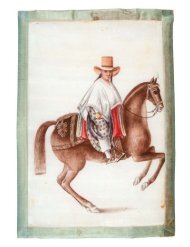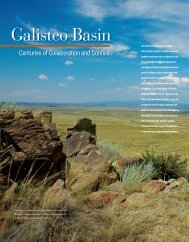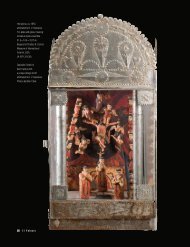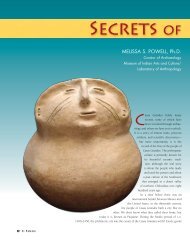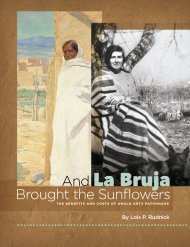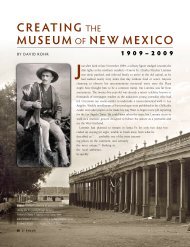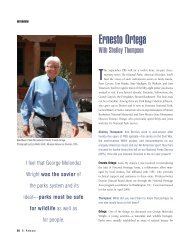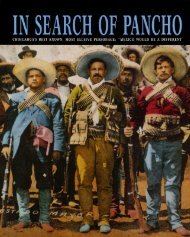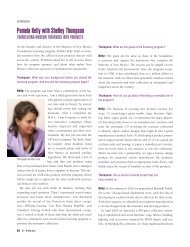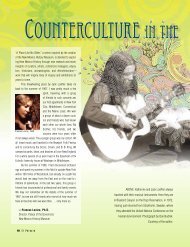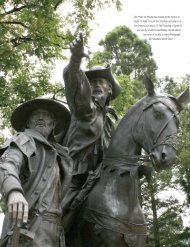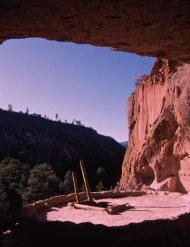Chasing the Cure in New Mexico - El Palacio Magazine
Chasing the Cure in New Mexico - El Palacio Magazine
Chasing the Cure in New Mexico - El Palacio Magazine
Create successful ePaper yourself
Turn your PDF publications into a flip-book with our unique Google optimized e-Paper software.
<strong>Chas<strong>in</strong>g</strong> <strong>the</strong> <strong>Cure</strong> <strong>in</strong> <strong>New</strong> <strong>Mexico</strong><br />
The Lungers and<br />
Their Legacy<br />
By Nancy Owen Lewis<br />
40 E l <strong>Palacio</strong>
“A Place Like No O<strong>the</strong>r,” a series <strong>in</strong>spired by <strong>the</strong><br />
creation of <strong>the</strong> <strong>New</strong> <strong>Mexico</strong> History Museum, is devoted<br />
to explor<strong>in</strong>g <strong>New</strong> <strong>Mexico</strong> history through new research<br />
and recent <strong>in</strong>sights of curators, artists, collections managers,<br />
educators, historians, archaeologists, anthropolgists,<br />
and ethnohistorians—work that will <strong>in</strong>spire l<strong>in</strong>es<br />
of <strong>in</strong>quiry and exhibitions for years to come.<br />
In this article, cultural anthropologist Nancy Owen<br />
Lewis recalls <strong>the</strong> promise that high-and-dry <strong>New</strong><br />
<strong>Mexico</strong> made to people suffer<strong>in</strong>g from lung diseases<br />
who sought a better life for a little longer.<br />
Frances Lev<strong>in</strong>e, Ph.D.<br />
Director, Palace of <strong>the</strong> Governors/<br />
<strong>New</strong> <strong>Mexico</strong> History Museum<br />
A PLACE LIKE No o<strong>the</strong>r<br />
Tuberculosis, once <strong>the</strong> lead<strong>in</strong>g cause of death <strong>in</strong><br />
America, brought thousands of health seekers to<br />
<strong>New</strong> <strong>Mexico</strong>. From 1880 to 1940 <strong>the</strong>y flocked to its<br />
mounta<strong>in</strong>s and deserts, hop<strong>in</strong>g to heal. Those with sufficient<br />
resources checked <strong>in</strong>to one of sixty sanatoriums,<br />
while o<strong>the</strong>rs “chased <strong>the</strong> cure on <strong>the</strong>ir feet.” These “lungers,”<br />
as <strong>the</strong>y were called, <strong>in</strong>cluded some of <strong>the</strong> “Who’s<br />
Who of <strong>New</strong> <strong>Mexico</strong>”: Will Shuster and Carlos Vierra, who<br />
“came to heal and stayed to pa<strong>in</strong>t”; William R. Lovelace<br />
and Edgar T. Lassetter, who upon recovery founded <strong>the</strong><br />
Lovelace Cl<strong>in</strong>ic; Dorothy McKibben, who wrote about<br />
J. Robert Oppenheimer and served as gatekeeper for <strong>the</strong><br />
Manhattan Project; and Cl<strong>in</strong>ton P. Anderson, who became<br />
a powerful United States senator.<br />
LEFT: "On <strong>the</strong> Grounds of a Sanatorium," Hicks, ca. 1925, promotional<br />
material showcas<strong>in</strong>g <strong>New</strong> <strong>Mexico</strong>'s salubrious climate and personal care.<br />
The Albuquerque Museum Photoarchives, PA 82.181.435.<br />
ABOVE: Santa Fe Trail Magaz<strong>in</strong>e, <strong>New</strong> <strong>Mexico</strong> Cottage Sanatorium,<br />
located three miles from Silver City, ca 1912. Neg. No. 05109,<br />
Palace of <strong>the</strong> Governors (MNM/DCA).<br />
<strong>El</strong> <strong>Palacio</strong> 41
<strong>New</strong> <strong>Mexico</strong> Cottage Sanatorium, located <strong>in</strong> <strong>the</strong> "Golden Climate" of Silver City, <strong>New</strong> <strong>Mexico</strong>, unattributed, n.d.<br />
Neg. No. 051095, Palace of <strong>the</strong> Governors (MNM/DCA).<br />
By 1920 health seekers comprised an estimated 10 percent<br />
of <strong>New</strong> <strong>Mexico</strong>’s population. Although <strong>the</strong> tubercle bacillus had<br />
been isolated <strong>in</strong> 1882, <strong>the</strong> development of streptomyc<strong>in</strong> and<br />
o<strong>the</strong>r effective drugs did not occur until <strong>the</strong> 1940s. Dur<strong>in</strong>g <strong>the</strong><br />
<strong>in</strong>terven<strong>in</strong>g decades, <strong>the</strong> medically approved regimen consisted<br />
of nutritious food, fresh air, and rest—preferably <strong>in</strong> a high, dry,<br />
and sunny place. With its high elevation, abundant sunsh<strong>in</strong>e, and<br />
arid climate, <strong>New</strong> <strong>Mexico</strong> was considered ideal.<br />
That fact was not lost on <strong>the</strong> <strong>New</strong> <strong>Mexico</strong> Bureau of Immigration.<br />
Once established <strong>in</strong> 1880, <strong>the</strong> bureau wasted no time <strong>in</strong> advertis<strong>in</strong>g<br />
<strong>the</strong> territory’s heal<strong>in</strong>g climate, partly to promote <strong>New</strong> <strong>Mexico</strong><br />
<strong>in</strong> its long struggle for statehood. <strong>New</strong> <strong>Mexico</strong>: The Tourists Shr<strong>in</strong>e,<br />
published <strong>in</strong> 1882, asserted that “<strong>the</strong> lowest death rate from<br />
tubercular disease <strong>in</strong> America is <strong>in</strong> <strong>New</strong> <strong>Mexico</strong>.” Local communities<br />
soon began promot<strong>in</strong>g <strong>the</strong>ir own heal<strong>in</strong>g properties. Santa<br />
Fe called itself <strong>the</strong> “Land of Sunsh<strong>in</strong>e.” Albuquerque’s slogan<br />
became “Heart of <strong>the</strong> Well Country,” while Silver City, plugged<br />
as <strong>the</strong> city “with <strong>the</strong> Golden Climate,” claimed it had <strong>the</strong> most<br />
salubrious climate of all.<br />
Health seekers began to arrive <strong>in</strong> 1880, when <strong>New</strong> <strong>Mexico</strong><br />
became more easily accessible with <strong>the</strong> com<strong>in</strong>g of <strong>the</strong> railroad,<br />
but facilities were limited until <strong>the</strong> turn of <strong>the</strong> century. A pamphlet<br />
issued <strong>in</strong> 1887 by <strong>the</strong> Silver City Bureau of Immigration<br />
stated that “<strong>in</strong> <strong>the</strong> hotels well-furnished, bright sunny rooms and<br />
good board can be had at very reasonable rates, while private<br />
board may be obta<strong>in</strong>ed <strong>in</strong> many families.” The pamphlet suggested<br />
that an <strong>in</strong>valid of limited means could “pitch his tent or<br />
build his cab<strong>in</strong> where he pleases without fear<strong>in</strong>g a land owner’s<br />
<strong>in</strong>terference.” Ranches were also recommended for <strong>the</strong> ail<strong>in</strong>g: “He<br />
42 E l <strong>Palacio</strong><br />
will be outdoors <strong>in</strong> <strong>the</strong> life-giv<strong>in</strong>g sunsh<strong>in</strong>e all day long, and that<br />
is what his condition demands,” wrote Charles Almy <strong>in</strong> an article<br />
appear<strong>in</strong>g <strong>in</strong> <strong>the</strong> June 8, 1900, edition of <strong>the</strong> Silver City Enterprise.<br />
Never<strong>the</strong>less, he warned that it might be “a difficult matter to get<br />
on a ranch unless one has friends who own one and are will<strong>in</strong>g<br />
to put up with an <strong>in</strong>valid.”<br />
Some heath seekers expressed dismay at what <strong>the</strong>y found<br />
when <strong>the</strong>y came to <strong>New</strong> <strong>Mexico</strong>. After be<strong>in</strong>g diagnosed with<br />
tuberculosis, Hugh A. Cooper, a Presbyterian m<strong>in</strong>ister from Iowa,<br />
arrived <strong>in</strong> Albuquerque <strong>in</strong> 1903 and was shocked by <strong>the</strong> lack<br />
of facilities. “We had noth<strong>in</strong>g here but <strong>the</strong> climate,” he reported<br />
<strong>in</strong> an account published by <strong>the</strong> Presbyterian Hospital Center <strong>in</strong><br />
1967. “Until com<strong>in</strong>g to this territory, I never realized <strong>the</strong> desolation<br />
of <strong>the</strong> consumptive. I could take <strong>the</strong> reader to tents or cheap<br />
room<strong>in</strong>g houses not far from my home where cultured people<br />
are liv<strong>in</strong>g on a poor and scanty diet.” Cooper recovered and<br />
went on to establish Southwestern Presbyterian Sanatorium <strong>in</strong><br />
Albuquerque.<br />
Although sanatoriums were already <strong>in</strong> use <strong>in</strong> Germany dur<strong>in</strong>g<br />
<strong>the</strong> n<strong>in</strong>eteenth century, <strong>the</strong>y didn’t become popular <strong>in</strong> <strong>the</strong> United<br />
States until physician Edward L. Trudeau cured himself of tuberculosis<br />
dur<strong>in</strong>g a retreat <strong>in</strong> <strong>the</strong> Adirondack Mounta<strong>in</strong>s. In 1885 he<br />
established <strong>the</strong> Adirondack Cottage Sanatorium, which became<br />
a model for <strong>the</strong> rest of <strong>the</strong> country. <strong>New</strong> <strong>Mexico</strong>’s old military<br />
forts were soon eyed as possible sanatorium sites. The impetus to<br />
convert <strong>the</strong>m, however, was provided by <strong>the</strong> Spanish American<br />
War, for by 1898 <strong>the</strong> U.S. Soldiers Home, <strong>in</strong> Wash<strong>in</strong>gton, D.C.,<br />
had been <strong>in</strong>undated with consumptive veterans. It quickly<br />
became apparent that facilities <strong>in</strong> a more salubrious climate were
needed. In 1899 authorities established <strong>the</strong> U.S. Mar<strong>in</strong>e Hospital<br />
Sanatorium at Fort Stanton, <strong>in</strong> L<strong>in</strong>coln County, and <strong>the</strong> U.S.<br />
Army General Hospital for tubercular soldiers at Fort Bayard, <strong>in</strong><br />
Grant County.<br />
In his 1908 Report to <strong>the</strong> Secretary of <strong>the</strong> Interior, territorial governor<br />
George Curry applauded <strong>the</strong> forts-turned-sanatoriums for<br />
<strong>the</strong>ir “splendid successes <strong>in</strong> <strong>the</strong> treatment of tuberculosis, which<br />
furnish constant and conv<strong>in</strong>c<strong>in</strong>g proof of <strong>the</strong> right of <strong>New</strong> <strong>Mexico</strong><br />
to <strong>the</strong> title of ‘<strong>the</strong> nation’s sanatorium.’” <strong>New</strong> <strong>Mexico</strong>, <strong>in</strong> fact, cont<strong>in</strong>ued<br />
to welcome health seekers long after o<strong>the</strong>r states tried to<br />
restrict <strong>the</strong>ir immigration. Tax breaks were offered for sanatorium<br />
construction, and <strong>in</strong> 1908 <strong>New</strong> <strong>Mexico</strong> ranked fifth <strong>in</strong> <strong>the</strong> nation<br />
<strong>in</strong> <strong>the</strong> number of beds for tubercular patients.<br />
When <strong>New</strong> <strong>Mexico</strong> f<strong>in</strong>ally achieved statehood <strong>in</strong> 1912, thirty<br />
sanatoriums had been built, and ano<strong>the</strong>r thirty would be established<br />
<strong>in</strong> <strong>the</strong> decades that followed. Churches played a key role<br />
<strong>in</strong> <strong>the</strong> operation of <strong>the</strong>se facilities, which <strong>in</strong>cluded St. V<strong>in</strong>cent<br />
Sanatorium <strong>in</strong> Santa Fe, St. Joseph’s Sanatorium <strong>in</strong> Silver City<br />
and Albuquerque, Holy Cross Sanatorium <strong>in</strong> Dem<strong>in</strong>g, and <strong>the</strong><br />
Methodist Deaconess Sanatorium <strong>in</strong> Albuquerque.<br />
Private sanatoriums also flourished—many of <strong>the</strong>m founded<br />
by health-seek<strong>in</strong>g physicians who came west to chase <strong>the</strong> cure<br />
and stayed to heal <strong>the</strong> sick. In 1904 William T. Brown purchased<br />
land outside Watrous and built Valmora Industrial Sanatorium<br />
to provide care for stricken workers from <strong>the</strong> Chicago area. Carl<br />
Gellenthien, a former patient, succeeded him as medical director.<br />
In 1905 Earl Bullock founded Cottage San <strong>in</strong> Silver City, and <strong>the</strong><br />
follow<strong>in</strong>g year Frank Mera purchased Sunmount Tent City <strong>in</strong> Santa<br />
Fe and turned it <strong>in</strong>to an upscale tuberculosis sanatorium. Billed as<br />
“The Sanatorium Different,” Sunmount attracted artists, writers,<br />
and o<strong>the</strong>r lum<strong>in</strong>aries such as poet Alice Corb<strong>in</strong> Henderson and<br />
John Gaw Meem. Meem recovered to become one of <strong>New</strong> <strong>Mexico</strong>’s<br />
lead<strong>in</strong>g architects. Henderson, who lived to age sixty-eight, cont<strong>in</strong>ued<br />
to write and became curator at <strong>the</strong> Wheelwright Museum<br />
of <strong>the</strong> American Indian, which was designed by her husband,<br />
William Penhallow Henderson, <strong>in</strong> 1937.<br />
Treatment was based on four card<strong>in</strong>al pr<strong>in</strong>ciples: rest, fresh air,<br />
ample good food, and a positive attitude. “Too much emphasis<br />
cannot be made on <strong>the</strong> absolute necessity of enforced quiet and<br />
rest <strong>in</strong> <strong>the</strong> treatment of tuberculosis,” stated L. G. Rice, president<br />
of <strong>the</strong> state Board of Health. “A comfortable chair, preferably of<br />
<strong>the</strong> Adirondack type, located where <strong>the</strong>re is lots of fresh air, without<br />
exposure to drafts and storms and with a pleasant outlook,<br />
is a very great help.” His recommendations appeared <strong>in</strong> <strong>the</strong> May<br />
1914 issue of <strong>the</strong> Killgloom Gazette, an Albuquerque newsletter<br />
that offered advice to health seekers.<br />
<strong>New</strong> <strong>Mexico</strong> Cottage Sanatorium, <strong>in</strong>terior, Silver City, <strong>New</strong> <strong>Mexico</strong>, unattributed, n.d.<br />
Neg. No. 051094, Palace of <strong>the</strong> Governors (MNM/DCA).<br />
St. V<strong>in</strong>cent’s Hospital room, Jesse L. Nusbaum, 1910.<br />
Neg. No. 061377, Palace of <strong>the</strong> Governors (MNM/DCA).<br />
A PLACE LIKE No o<strong>the</strong>r<br />
To take full advantage of <strong>the</strong> climate, consumptives were<br />
encouraged to get as much fresh air as possible. Patients at Fort<br />
Stanton, for example, were required to “stay outdoors at least<br />
eight hours daily and always when <strong>in</strong>doors keep <strong>the</strong> w<strong>in</strong>dows<br />
open.” At Sunmount Sanatorium, <strong>in</strong>valids slept <strong>in</strong> special cottages<br />
equipped with small, screened sleep<strong>in</strong>g porches, while at<br />
Valmora, patients used mirrors to direct <strong>the</strong> sun’s rays down <strong>the</strong>ir<br />
throats, a practice known as helio<strong>the</strong>rapy. Smok<strong>in</strong>g and chew<strong>in</strong>g<br />
tobacco <strong>in</strong> moderation were permitted, but strict rules were<br />
imposed on spitt<strong>in</strong>g: “only <strong>in</strong> your spit cup or <strong>in</strong>to <strong>the</strong> large spittoons<br />
provided for that purpose.”<br />
Because tuberculosis literally consumed its victims, sanatoriums<br />
plied <strong>the</strong>ir patients with food. “I have known patients who<br />
<strong>El</strong> <strong>Palacio</strong> 43
Croquet at Sunmount. Outdoor activities were key to treat<strong>in</strong>g TB patients, who were<br />
encouraged to soak up <strong>the</strong> sun and brea<strong>the</strong> <strong>New</strong> <strong>Mexico</strong>'s dry air. <strong>New</strong> <strong>Mexico</strong> State<br />
Records Center & Archives, John Gaw Meem Photo Collection 0147, #23505.<br />
were dr<strong>in</strong>k<strong>in</strong>g 26 glasses of milk and swallow<strong>in</strong>g a dozen raw<br />
eggs per day, and <strong>in</strong> addition were mak<strong>in</strong>g a brave attempt to eat<br />
three meals that would do credit to a harvest hand,” wrote physician<br />
LeRoy Peters <strong>in</strong> an article appear<strong>in</strong>g <strong>in</strong> <strong>the</strong> August 1914 issue<br />
of <strong>the</strong> Killgloom Gazette. Ga<strong>in</strong><strong>in</strong>g weight was considered such<br />
an important <strong>in</strong>dicator of progress that <strong>in</strong> his 1901 Report to <strong>the</strong><br />
Secretary of <strong>the</strong> Interior, Governor Miguel Otero <strong>in</strong>cluded a list of<br />
100 patients at Fort Stanton that stated how much weight each<br />
had ga<strong>in</strong>ed dur<strong>in</strong>g <strong>the</strong> last week <strong>in</strong> December.<br />
If a patient failed to make progress, <strong>the</strong> physician might prescribe<br />
postural dra<strong>in</strong>age—dra<strong>in</strong><strong>in</strong>g fluid from <strong>the</strong> lungs by hang<strong>in</strong>g<br />
<strong>the</strong> afflicted person upside-down—or artificial pneumothorax,<br />
<strong>the</strong> <strong>in</strong>tentional collapse of a diseased lung <strong>in</strong> order to allow<br />
it to rest and heal. This procedure <strong>in</strong>volved <strong>in</strong>sert<strong>in</strong>g an <strong>in</strong>ert gas<br />
<strong>in</strong>to <strong>the</strong> pleural cavity, which <strong>in</strong>itially proved difficult. “For two<br />
years we worked without advantage of . . . X-ray equipment,”<br />
recalled Peters <strong>in</strong> an article appear<strong>in</strong>g <strong>in</strong> <strong>the</strong> February 1940 issue<br />
of Southwestern Medic<strong>in</strong>e. “Lungs were over-compressed [and]<br />
diaphragms pushed downward with displacement of liver and<br />
o<strong>the</strong>r abdom<strong>in</strong>al viscera, and many times <strong>the</strong> unhappy patient<br />
made worse than better.”<br />
Regardless of <strong>the</strong> <strong>the</strong>rapies used, treatment was a slow process,<br />
and consumptives who checked <strong>in</strong>to a <strong>New</strong> <strong>Mexico</strong> sanatorium<br />
could anticipate an average stay of n<strong>in</strong>e months. Upon admission,<br />
patients faced <strong>the</strong> dual challenge of adjust<strong>in</strong>g to life <strong>in</strong> a highly<br />
regimented environment and cultivat<strong>in</strong>g “a cheerful and hopeful<br />
spirit.” As Rice expla<strong>in</strong>ed, one’s attitude has “a great <strong>in</strong>fluence<br />
over <strong>the</strong> processes of <strong>the</strong> body.”<br />
To help patients ma<strong>in</strong>ta<strong>in</strong> an upbeat attitude, many sanatoriums<br />
offered occupational <strong>the</strong>rapy and diversions such as billiards<br />
44 E l <strong>Palacio</strong><br />
and croquet. Sunmount, for example, hosted mariachi concerts,<br />
horseback rides, and excursions to nearby pueblos. Patients<br />
attended lectures by archaeologist Sylvanus Morley and poetry<br />
read<strong>in</strong>gs by Carl Sandburg. Percy Pogson offers a glimpse of <strong>the</strong><br />
activities at Cottage San <strong>in</strong> an album he made while a patient<br />
<strong>the</strong>re from 1914 to 1915 that <strong>in</strong>cludes pictures of “golf<strong>in</strong>g lungers,”<br />
horseback rid<strong>in</strong>g trips, and picnics. Pogson recovered and<br />
moved to <strong>El</strong> Paso, where he died at <strong>the</strong> age of eighty.<br />
O<strong>the</strong>r health seekers were not so fortunate. Helen Nor<strong>in</strong>e was<br />
a teenager when she was admitted to St. Joseph’s Sanatorium <strong>in</strong><br />
1913. Her life is vividly portrayed <strong>in</strong> a series of letters, now at <strong>the</strong><br />
Silver City Museum, which she sent to her family <strong>in</strong> M<strong>in</strong>nesota.<br />
On November 23 she wrote: “Dear Mo<strong>the</strong>r: I got blood tonic this<br />
morn<strong>in</strong>g and it hurts like h—l. Say I don’t want anyone to come<br />
down for Xmas cause I won’t be well enough to be out of bed and<br />
it will be so cold and everyth<strong>in</strong>g. I’d ra<strong>the</strong>r have someone come<br />
later on when I’m up and can go for a ride around <strong>the</strong> country<br />
or go to some neighbor<strong>in</strong>g town for fun.” Helen, at age eighteen,<br />
died three months later of pulmonary tuberculosis.<br />
Nor<strong>in</strong>e’s case was not exceptional. One study estimated that<br />
from <strong>the</strong> beg<strong>in</strong>n<strong>in</strong>g of <strong>the</strong> sanatorium movement through <strong>the</strong><br />
1940s, nearly 25 percent of patients died <strong>in</strong> <strong>the</strong> hospital, while<br />
50 percent of those released succumbed with<strong>in</strong> five years of discharge.<br />
Despite <strong>the</strong>se grim statistics, health seekers cont<strong>in</strong>ued to<br />
pour <strong>in</strong>to <strong>New</strong> <strong>Mexico</strong>.<br />
Not everyone welcomed <strong>the</strong>m. Mela Koeber recalled that when<br />
she was a little girl, “Everybody was scared to death of <strong>the</strong> people<br />
who came out here with tuberculosis. I was warned absolutely<br />
not to play with children who came from TB families,” she said<br />
<strong>in</strong> an account published <strong>in</strong> Sh<strong>in</strong><strong>in</strong>g River Precious Land: An Oral
Cultivat<strong>in</strong>g Cheer<br />
A number of sanatoriums had newsletters, such as <strong>the</strong> as<br />
<strong>the</strong> Killgloom Gazette, which was <strong>in</strong>itiated <strong>in</strong> January 1914<br />
by patients at <strong>the</strong> Methodist Deaconess Sanatorium. The<br />
Killgloom Gazette soon evolved from a mimeographed sheet<br />
to a pr<strong>in</strong>ted publication, and <strong>in</strong> September 1914 it became<br />
<strong>the</strong> Herald of <strong>the</strong> Well Country. The newsletters offered<br />
advice to <strong>the</strong> health seeker and also provided <strong>in</strong>formation<br />
about activities as well as arrivals and departures <strong>in</strong> <strong>the</strong><br />
various “sans.”<br />
To help <strong>the</strong> health seeker “cultivate a cheerful and hopeful<br />
spirit,” <strong>the</strong>y also were full of jokes and poems, such<br />
as <strong>the</strong> follow<strong>in</strong>g from <strong>the</strong> July 1914 issue of <strong>the</strong> Killgloom<br />
Gazette:<br />
Little Bo Peep,<br />
Could not sleep,<br />
But coughed <strong>the</strong> whole night thru<br />
She scattered <strong>the</strong> bugs<br />
All over <strong>the</strong> rugs<br />
Now her sheep have T.B. too.<br />
O<strong>the</strong>r jokes and poems from The Killgloom Gazette, <strong>in</strong>clude:<br />
She (weepfully): Last summer you swore to love me until<br />
death should part us.<br />
He: I know, but you must remember that four doctors had<br />
just said you couldn't live three months.<br />
And:<br />
The Tale of <strong>the</strong> TB who Wouldn’t Chase,<br />
Chapter 1: Cough<strong>in</strong><br />
Chapter II: Scoff<strong>in</strong><br />
Chapter III: Cough<strong>in</strong> Often<br />
Chapter IV: Off <strong>in</strong> Coff<strong>in</strong><br />
The Gazette also published more serious articles. Its August<br />
1914 edition, for example, offered <strong>the</strong> follow<strong>in</strong>g advice:<br />
A PLACE LIKE No o<strong>the</strong>r<br />
The o<strong>the</strong>r day our attention was called to <strong>the</strong> attitude<br />
of a healthseeker [who] . . . made <strong>the</strong> remark<br />
that he didn’t like to th<strong>in</strong>k of himself as a lunger.<br />
In a way we can’t blame any one for feel<strong>in</strong>g . . .<br />
like that, [but] <strong>the</strong> attitude is certa<strong>in</strong>ly a detriment<br />
to a speedy and thorough cure . . . The TB is not<br />
like o<strong>the</strong>r folks and never will be unless he th<strong>in</strong>ks<br />
of himself as a TB and acts like one, which means<br />
to watch his temp, his diet and to conserve every<br />
energy—which is to chase. —NOL<br />
Excerpts from <strong>the</strong> Killgloom Gazette, Vol. 1, Nos. 4, 5 (cover reproduced)<br />
and 7 (1914). Albuquerque and <strong>New</strong> <strong>Mexico</strong> Pamphlet Collection, MSS 122<br />
BC, Center for Southwest Research, Albuquerque, <strong>New</strong> <strong>Mexico</strong>.<br />
<strong>El</strong> <strong>Palacio</strong> 45
A PLACE LIKE No o<strong>the</strong>r<br />
History of Albuquerque’s North Valley (Albuquerque Museum,<br />
1986). Many hotels would not accept tuberculars, and want ads<br />
for apartments frequently said “No Sick.” A health seeker able<br />
to pay <strong>the</strong> $50 to $100 monthly fee to stay at a sanatorium was<br />
one th<strong>in</strong>g, but thousands scarcely had enough to pay for <strong>the</strong>ir<br />
tra<strong>in</strong> ticket.<br />
“They are sent to us or drift here <strong>in</strong> all stages of <strong>the</strong> disease, and<br />
only too often without <strong>in</strong>come or friends,” wrote C. M. Mayes <strong>in</strong><br />
<strong>the</strong> November 1909 issue of <strong>the</strong> Journal of <strong>the</strong> <strong>New</strong> <strong>Mexico</strong> Medical<br />
Society. “They sit about our parks, on our curbs, <strong>in</strong> our places<br />
of amusement and recreation—a menace to <strong>the</strong> exposed and a<br />
burden both to <strong>the</strong>mselves and our citizenship.”<br />
To address <strong>the</strong> problem, cities changed <strong>the</strong>ir advertis<strong>in</strong>g strategies.<br />
In 1914 <strong>the</strong> Commercial Club issued a pamphlet titled,<br />
“Why Albuquerque, <strong>New</strong> <strong>Mexico</strong> Will Make You Well.” The<br />
back cover, however, warned:<br />
DON’T come to Albuquerque for health:<br />
1. If you are broke—<br />
2. As a last resort<br />
3. Expect<strong>in</strong>g to get well <strong>in</strong> a week<br />
4. Albuquerque does not <strong>in</strong>vite <strong>in</strong>digent or hopeless cases.<br />
ABOVE: Promotional material for Albuquerque, which purported to be “<strong>in</strong> <strong>the</strong> Heart of Well Country.”<br />
Albuquerque and <strong>New</strong> <strong>Mexico</strong> Pamphlet Collection, Center for Southwest Research, Albuquerque, <strong>New</strong> <strong>Mexico</strong>.<br />
BELOW: TB Sanatorium, Socorro, <strong>New</strong> <strong>Mexico</strong>, 1939. Neg. No. 052183, Palace of <strong>the</strong> Governors (MNM/DCA).<br />
46 E l <strong>Palacio</strong><br />
In promot<strong>in</strong>g <strong>New</strong> <strong>Mexico</strong><br />
as a health resort, officials<br />
cont<strong>in</strong>ued to stress<br />
not only its salubrious<br />
climate but also <strong>the</strong> health<br />
of local residents. “That<br />
<strong>the</strong> native people of this<br />
section experience such<br />
wonderful immunity from<br />
tuberculosis, especially of<br />
<strong>the</strong> respiratory tracts, must<br />
have its explanation <strong>in</strong> <strong>the</strong><br />
very favorable climatic conditions<br />
surround<strong>in</strong>g.” This<br />
statement, issued <strong>in</strong> 1906 by<br />
<strong>the</strong> Bureau of Immigration, was followed by similar reports.<br />
In 1918, however, several events occurred that would dramatically<br />
alter this perception. That summer, several hundred<br />
<strong>New</strong> <strong>Mexico</strong> soldiers were discharged from <strong>the</strong> military because<br />
of tuberculosis. Hop<strong>in</strong>g to f<strong>in</strong>d treatment for <strong>the</strong>m, Governor<br />
Wash<strong>in</strong>gton E. L<strong>in</strong>dsey contacted numerous sanatoriums, only<br />
to f<strong>in</strong>d that beds were occupied by out-of-state health seekers.<br />
Governor L<strong>in</strong>dsey also sought help from <strong>the</strong> adjutant general <strong>in</strong><br />
Wash<strong>in</strong>gton, but to no avail.
He <strong>the</strong>n contacted <strong>the</strong> U.S. surgeon general, who sent J. W.<br />
Kerr, a physician from <strong>the</strong> U.S. Public Health Service, to conduct<br />
a statewide health survey. Kerr was shocked to discover that “<strong>the</strong><br />
death rate from tuberculosis among <strong>the</strong> Indians <strong>in</strong> <strong>New</strong> <strong>Mexico</strong><br />
is over twice that of <strong>the</strong> average <strong>in</strong> <strong>the</strong> Registration Area and that<br />
disease is estimated to cause over 800 deaths (not migratory<br />
health seekers) annually <strong>in</strong> our State.”<br />
At Kerr’s urg<strong>in</strong>g, <strong>New</strong> <strong>Mexico</strong> established <strong>the</strong> Department of<br />
Health <strong>in</strong> 1919, which immediately began tackl<strong>in</strong>g <strong>the</strong> state’s<br />
many health problems, <strong>in</strong>clud<strong>in</strong>g tuberculosis. In 1936 <strong>the</strong> state<br />
established its own sanatorium, which provided free treatment<br />
to <strong>in</strong>digent <strong>New</strong> Mexicans. By this time, however, <strong>the</strong> sanatorium<br />
movement had begun to wane. Dur<strong>in</strong>g <strong>the</strong> Depression,<br />
<strong>the</strong> flood of out-of-state health seekers dw<strong>in</strong>dled sharply, s<strong>in</strong>ce<br />
fewer people could afford <strong>the</strong> luxury of extended care <strong>in</strong> a private<br />
sanatorium. Many came to realize that it was <strong>the</strong> sanatorium<br />
regimen—with its emphasis on rest, diet, and fresh air—and not<br />
its location that was critical.<br />
The end of <strong>the</strong> health-seeker movement came <strong>in</strong> 1944 with<br />
<strong>the</strong> discovery of streptomyc<strong>in</strong>, and eventually o<strong>the</strong>r drugs,<br />
which proved effective <strong>in</strong> treat<strong>in</strong>g tuberculosis. Sanatoriums<br />
had become medical anachronisms. One by one <strong>the</strong>y closed,<br />
many convert<strong>in</strong>g to o<strong>the</strong>r uses. Sunmount became a Carmelite<br />
ABOVE: Cottages at Sunmount – "The Sanatorium Different" – Santa Fe, <strong>New</strong> <strong>Mexico</strong>, 1913.<br />
Jesse L. Nusbaum, Neg. No. 061391, Palace of <strong>the</strong> Governors (MNM/DCA).<br />
INSET: Valmora Ranch Sanatorium, Watrous, <strong>New</strong> <strong>Mexico</strong>, unattributed.<br />
Neg. No. 178018, Palace of <strong>the</strong> Governors (MNM/DCA).<br />
Monastery. St. Joseph’s Sanatorium <strong>in</strong> Silver City was converted<br />
<strong>in</strong>to apartments, while Valmora became a residential treatment<br />
center for adolescents.<br />
One by one <strong>the</strong> physicians died as well, LeRoy Peters <strong>in</strong> 1941<br />
and Frank Mera <strong>in</strong> 1970. When Carl Gellenthien died <strong>in</strong> 1989,<br />
his epitaph spoke to <strong>the</strong> pass<strong>in</strong>g of an era: “He Came a Lunger,<br />
He Left a Legacy.” n<br />
Nancy Owen Lewis, Ph.D., is director of scholar programs at <strong>the</strong> School<br />
for Advanced Research, <strong>in</strong> Santa Fe, <strong>New</strong> <strong>Mexico</strong>, and co-author of<br />
A Peculiar Alchemy: A Centennial History of SAR, 1907–2007. Her article<br />
for <strong>El</strong> <strong>Palacio</strong> is based on research funded by <strong>the</strong> <strong>New</strong> <strong>Mexico</strong> Office of <strong>the</strong><br />
State Historian.<br />
<strong>El</strong> <strong>Palacio</strong> 47



